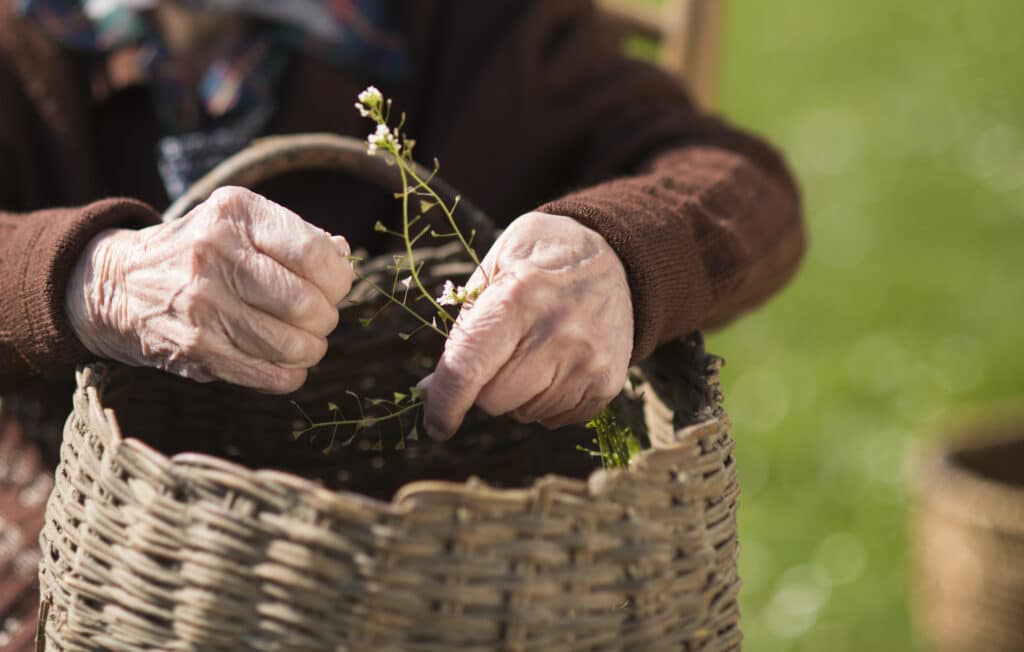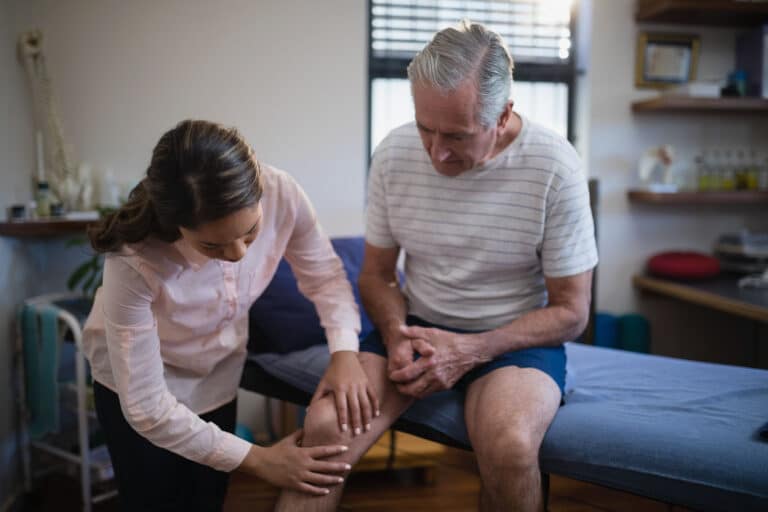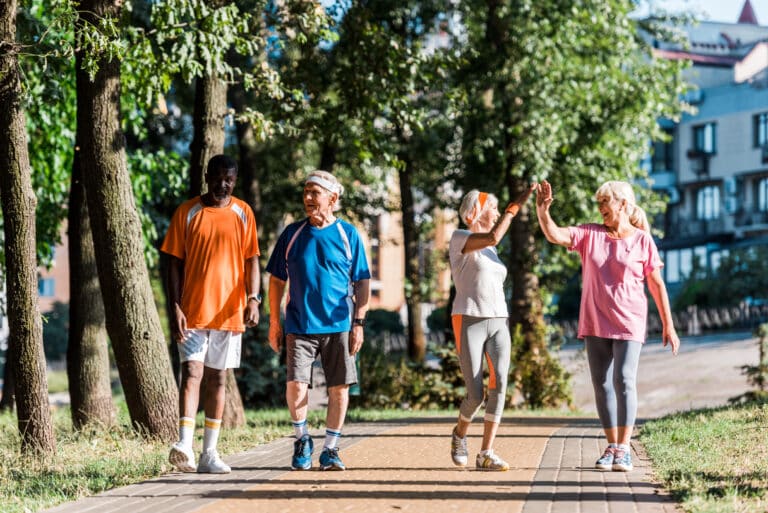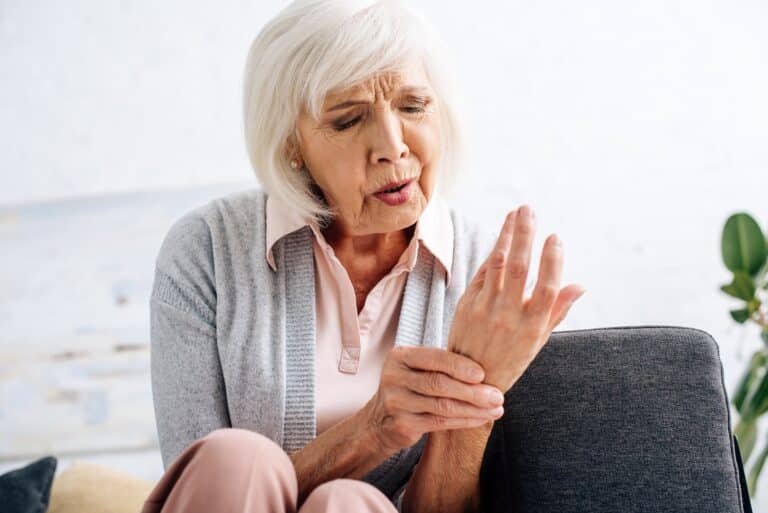Arthritis is one of the most common conditions older adults face worldwide. While there is a lot now known about arthritis, there are also still some big unknowns. Common myths and misconceptions can confuse those looking for good information.
As a physical therapist who has lots of experience helping older adults better manage their arthritis, I aim to promote a better understanding of arthritis while offering you some clarity around common arthritis myths.
In this article, I’ll share some common myths about arthritis and their explanations. I’ll also provide some insight and tips on how to manage arthritis from the perspective of a physical therapist. The main goal of this article is to give you relevant, reliable, and helpful information that will help you understand arthritis better than before.
What is Arthritis?
Before we cover some common facts and myths about arthritis, let’s review what the term “arthritis” actually means.
Arthritis is a general term that refers to conditions that affect the joints and cause pain, stiffness, swelling, and reduced mobility. There are many varieties of arthritis, but some of the most common are osteoarthritis, rheumatoid arthritis, gout, and psoriatic arthritis.
Arthritis affects millions of older adults worldwide and is considered a leading cause of disability.1
In addition to causing joint pain and stiffness, arthritis can significantly impact physical, mental, and social well-being.
Current research illustrates that osteoarthritis is the most common form of arthritis among older adults today. I can attest to this as I see it among many, if not most, of my older patients daily.
In the next section, we’ll mention multiple types of arthritis as we walk through some common myths and facts about them.
Is Arthritis Hereditary?

Many people with arthritis wonder whether their condition is hereditary. In other words, is arthritis something you inherit from your parents or family members, or is it something you develop on your own?
The answer to this question is complicated because arthritis is not a single disease but a complex group of conditions associated with different causes.
However, in general, genetics plays a role in arthritis development and risk, but it is just one factor among several.
Common Genetic Arthritis Types
Some types of arthritis have a more substantial genetic component than others. For example, rheumatoid arthritis, psoriatic arthritis, and ankylosing spondylitis are considered autoimmune diseases. This means the body’s immune system mistakenly attacks its tissues, causing inflammation and damage.
These types of arthritis are influenced by certain genes that regulate the immune system and its response to foreign substances. People who have these genes are more likely to develop these types of arthritis, especially if they are exposed to specific environmental triggers, like work stress, smoking, or even certain infections.2
Osteoarthritis and Genetics
Other types of arthritis, such as osteoarthritis, are more related to the wear and tear of joints. Regardless, osteoarthritis is still influenced by genes affecting the cartilage, bone, and other joint tissues. People with certain types of these genes may be more likely to develop osteoarthritis, especially if they have other risk factors.
Some rare types of arthritis are caused by specific genetic mutations or syndromes, such as juvenile idiopathic arthritis, which affects children and adolescents, and Ehlers-Danlos syndrome, which affects the connective tissues.
Osteoarthritis is also not limited to joint overuse, as is popularly believed. While many athletes may develop overuse-related arthritis, I’ve also worked with many older adults who have significant osteoarthritis despite a sedentary lifestyle. This indicates that factors like genetics may still play a role, regardless of activity levels.3
This all points to the idea that arthritis is partly hereditary, but other factors also contribute. While genetics can increase or decrease your risk of developing some forms of arthritis, they do not determine the entire future of your condition.
It’s important to note that despite your genetics, you can delay the progression of arthritis and maintain your joint function by caring for your health through regular activity and self-care.
Other Myths & Facts about Arthritis
Many myths and misconceptions about arthritis can affect how we perceive and manage the condition. Some myths are based on outdated or inaccurate information, while cultural or personal beliefs influence others.
Let’s take a few moments to debunk some of the most common myths about arthritis and provide some facts to better explain how arthritis develops and affects the lives of older adults.
Myth: Arthritis only affects older people
One of the most prevalent myths about arthritis is that it is a disease of old age and that young people are immune to it.
This myth is partly fueled by the fact that arthritis is more common among older adults, as the joints of the body tend to wear down over time. However, this does not mean that arthritis is exclusive to seniors or that young people are safe.
Fact: Arthritis can affect anyone at any age, including children and young adults
Arthritis represents many conditions affecting people of all ages, genders, and backgrounds.
In fact, according to the Arthritis Foundation, about 300,000 children and teens in the United States have some form of arthritis or rheumatic disease, and about 54 million adults have doctor-diagnosed arthritis.4
Some types of arthritis are more likely to affect younger people than others. For example, juvenile idiopathic arthritis (JIA) is the most common type of arthritis in children and adolescents, and it can cause pain, stiffness, swelling, and reduced mobility in one or more joints.
Another example is rheumatoid arthritis (RA), which is an autoimmune disease that can affect people as young as 30, sometimes even younger.
In fact, I’ve even worked with some adults under the age of 40 who have needed total hip replacements due to severe osteoarthritis. While this has often been due to repetitive high-impact sports or work activities, it’s a good reminder for adults of all ages to monitor how their activities affect them and watch for any early signs of arthritis.
Young people with arthritis face many challenges and complications, including chronic pain, fatigue, and emotional distress.
Anyone with arthritis must get an early diagnosis and start treatment immediately to avoid the worst effects of this condition. With the proper support and education, it’s possible to improve the quality of life and prevent long-term disability for both younger and older adults.
Myth: Arthritis is caused by cracking your knuckles or wearing high heels

Another common myth about arthritis is that it is caused by seemingly harmless habits, such as cracking your knuckles or wearing high heels.
This myth is based on the assumption that these actions cause damage over time and wear out your joints faster, leading to osteoarthritis. However, there isn’t scientific evidence that supports this claim.
Fact: Arthritis is caused by a combination of genetic, environmental, and lifestyle factors, not by specific habits or activities
Remember that arthritis involves environmental and lifestyle factors that interact and influence each other. Some of these factors are genetic, as discussed in the previous section, while others are environmental and lifestyle-related.
The Role of Personal & Lifestyle Factors
Lifestyle factors are related to your choices and behaviors, such as diet, weight, smoking, exercise, and stress. For example, a healthy diet can provide your body with the nutrients it needs to fight inflammation, heal tissue, and limit the development of some forms of arthritis.
Similarly, a healthy weight can reduce the pressure and strain on your joints, mainly your knees, hips, and spine.
Personal factors like joint overuse, injury, or infection can trigger inflammation and wear in your joints, especially if you have a genetic predisposition for arthritis. For example, a joint injury can cause cartilage breakdown, bone spurs, or loss of joint space, leading to osteoarthritis.
Environmental Factors and Other Contributors
Environmental factors like pollution can increase oxidative stress and inflammation, worsening arthritis symptoms. Climate can affect joint pain and stiffness, depending on the temperature, humidity, and barometric pressure.
In some cases, seemingly unrelated factors like infection can cause your immune system to attack your tissues, causing rheumatoid arthritis.
Exercise is one of the most promising lifestyle factors to improve joint health and delay the progression of some forms of arthritis, especially osteoarthritis. It can help you strengthen the muscles supporting your joints, maintain joint mobility, and improve joint circulation for enhanced healing or recovery.
While arthritis may be influenced to some degree by habits like cracking your knuckles or wearing high heels, these habits are generally harmless in moderation. 5, 6
What matters most is the combination of genetic, environmental, and lifestyle factors that affect your joint health and function throughout your life.
In short, cracking your knuckles or wearing high heels in excess may not be good for your joints, but they are likely not the sole cause of arthritis for older adults.
Myth: Arthritis is a minor condition that can be cured with supplements or home remedies
Another common myth about arthritis is that it is a minor condition or can be easily cured with supplements.
This myth is based on the belief that arthritis is caused by inflammation and that certain natural substances can reduce inflammation and heal the joints. However, this isn’t entirely true, and little scientific evidence fully supports this claim.
Fact: Arthritis is a serious condition with no cure that requires comprehensive treatment
Arthritis is not a trivial condition, but it is also not always severe. It is a chronic condition occurring at varying levels of intensity. It can have a significant impact on your physical and mental health.
In some cases, arthritis can cause considerable pain and stiffness, making daily activities such as walking, climbing stairs, dressing, or cooking difficult.
Arthritis can cause stress, anxiety, and depression that can interfere with your work, education, relationships, and hobbies. At the same time, arthritis can also increase your healthcare costs and your dependence on friends or family, affecting your financial and social status.
Arthritis Should Always Be Taken Seriously
While there is no known cure for arthritis, many treatments can help you manage your arthritis symptoms and improve your quality of life.
Some of these treatments include medications, physical therapy, exercise, and, in some cases, joint replacement surgery.
Supplements Commonly Associated with Arthritis
Some supplements available today, such as fish oil, glucosamine, and chondroitin, are marketed to improve joint health and reduce the symptoms of osteoarthritis to varying degrees.
However, not all supplements or home remedies are known to be beneficial for arthritis or entirely safe. For example, turmeric is a popular supplement for managing inflammation. Unfortunately, it can also interfere with some people’s blood clotting and liver function.
While turmeric shows some promise for controlling inflammation, it does not address the root cause of arthritis, such as repetitive stress or damaged cartilage.
In my experience working with many older adults who take several supplements for their arthritis, I see the most success with trying different combinations of treatment and clinically sound supplements. However, this should always be done under the supervision of your healthcare provider to see what works best for you.
Creating your plan of care alone is usually not the best approach when navigating the misinformation available on the internet. Always consult your doctor before taking any supplements or home remedies for your arthritis, and follow their advice carefully.
How to Manage Arthritis: A Physical Therapist’s Perspective

As a physical therapist with experience helping many older adults manage their arthritis, I want to share some insight on coping with these conditions and maintaining long-term function.
In its most basic form, physical therapy involves using exercises, manual techniques, pain management strategies, and education to help older adults with arthritis feel and move better. Here are some ways physical therapy can help you manage your arthritis.
Reducing Pain and Inflammation
Physical therapy can use modalities like heat, cold, massage, and electrical stimulation to reduce pain in your joints and muscles. These modalities stimulate blood flow, relax muscles, and block pain signals.
Improving Joint Function & Mobility
You’ll learn strengthening and stretching exercises in physical therapy to improve your joint function and mobility. These exercises can help you maintain or increase your range of motion, strengthen your muscles, and limit excessive joint stress.
Preventing or Delaying Surgery or Joint Replacement
While surgery, such as a joint replacement, might be needed to treat your arthritis, physical therapy can help you delay the need for surgery and, in some cases, prevent it entirely.
When joint replacement surgery is needed, physical therapy activities can help you prepare for your surgery by optimizing your physical condition and educating you on what to expect.
Enhancing Your Quality of Life and Well-Being
Physical therapy can help you feel more confident in your everyday life by enabling you to perform your daily activities with less pain and difficulty. This can also mean resuming or participating in your favorite hobbies and social activities more regularly.
Of course, physical therapy doesn’t just happen in the clinic. You’ll also be able to learn strategies to exercise and manage your arthritis symptoms more effectively at home, helping you feel more independent and enabling you to stay active for the long term.
Key Takeaways
- Arthritis is a general term that refers to conditions that affect the joints and cause pain, stiffness, swelling, and reduced mobility.
- Arthritis is not a single disease but a complex group of conditions with different causes and triggers.
- Arthritis is partly hereditary but not entirely. While genetics can increase or decrease your risk of developing arthritis, they do not determine everything about the course of your condition.
- Arthritis is not a disease of old age; it can affect anyone at any age, including children and young adults. Some types of arthritis are more likely to affect younger people than others, such as juvenile idiopathic arthritis and rheumatoid arthritis.
- Arthritis is not caused by cracking your knuckles or wearing high heels but by genetic, environmental, and lifestyle factors that affect your joint health and function.
- Arthritis is not a minor condition that can be cured by taking supplements or home remedies. However, some treatments and therapies can help you manage your arthritis symptoms and improve your overall health.
- Physical therapy can help you manage your arthritis in various ways, such as reducing pain and inflammation, improving joint function and mobility, preventing or delaying surgery or joint replacement, and enhancing your quality of life and well-being.
References
- Senthelal S, Li J, Ardeshirzadeh S, et al. arthritis. [Updated 2023 Jun 20]. In: StatPearls [Internet]. Treasure Island (FL): StatPearls Publishing; 2023 Jan-. Available from: https://www.ncbi.nlm.nih.gov/books/NBK518992/
- Reactive Arthritis. National Institute of Arthritis and Musculoskeletal and Skin Diseases.
- Reynard LN, Loughlin J. The genetics and functional analysis of primary osteoarthritis susceptibility. Expert Rev Mol Med. 2013;15:e2. Published 2013 Feb 18. doi:10.1017/erm.2013.4
- Arthritis by The Numbers: Book of Trusted Facts and Figures. Arthritis Foundation.
- Castellanos J, Axelrod D. Effect of habitual knuckle cracking on hand function. Ann Rheum Dis. 1990 May;49(5):308-9. doi: 10.1136/ard.49.5.308. PMID: 2344210; PMCID: PMC1004074.
- Yildizgören MT, Ekiz T, Nizamogullari S, et al. Effects of habitual knuckle cracking on metacarpal cartilage thickness and grip strength. Hand Surg Rehabil. 2017;36(1):41-43. doi:10.1016/j.hansur.2016.09.001






